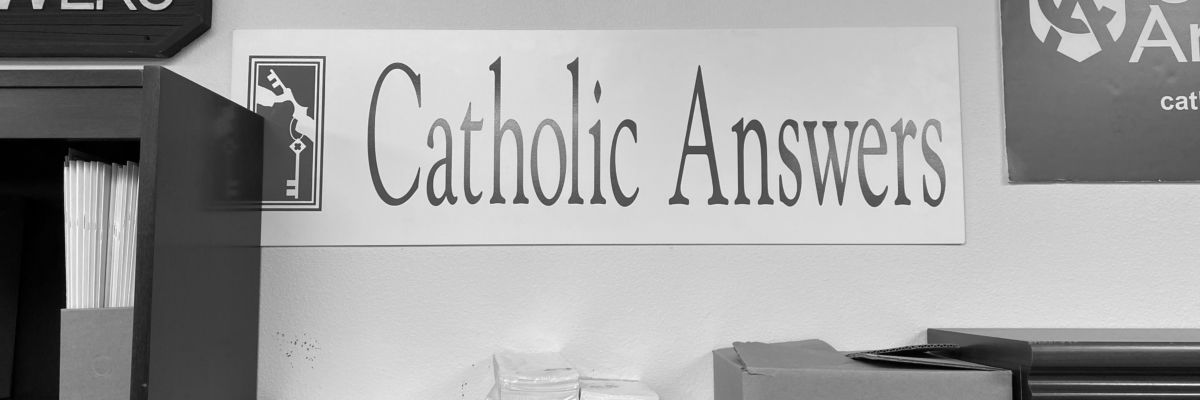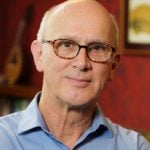
June ended up being the signal month for Earl W. La Riviere. It was the month in which he was born, the month in which he was ordained, and the month in which he died. For the last half dozen years of his life this sagacious and kindly man was Catholic Answers’ chaplain. He was known to us as Fr. Earl.
Only after his death last year did many of us, even those closest to him, begin to learn about certain periods of his life. To me he always had been the quintessential priest, so I was surprised to learn that, when he was about nineteen, he joined the U.S. Coast and Geodetic Survey—something unknown to me until the reception following his funeral.
Fr. Michael Sreboth, of the Archdiocese of Mobile, perhaps was closer to Fr. Earl than anyone. Though a generation apart, they developed a close bond that lasted thirty-four years. Fr. Sreboth met his mentor in 1962 at Aquinas High School, an all-boys institution in San Bernardino, California. He remembers the first day of ninth-grade English. The boys were rowdy, acting their age in the absence of an instructor. Suddenly the classroom door flew open and banged against the wall. In strode Fr. Earl, drill sergeant. “Sit down and shut up!” he commanded. Instant silence. There began a firm approach that transformed uncouth boys into solid Catholic men and, in many cases, academic successes.
On the school yard, disagreements occasionally ended in fisticuffs. When Fr. Earl discovered boys fighting, he did what Fr. Flanagan of Boys Town did. He got out boxing gloves, took the boys to the athletic fields, and let them go at one another. He acted as referee. “By the third round the boys were exhausted and the disagreement resolved,” remembers Fr. Sreboth.
Frank Haas, a student of Father’s at another school, recalls that “Fr. Earl was extraordinarily committed to his boys.” He was a no-nonsense instructor, not just in discipline, but in developing the minds of his charges. “I remember him booming out, ‘No! You’re wrong, my son!’ And then he’d explain the right answer carefully.” The boys loved it—and him.
So deep an influence did Fr. Earl become on his students that, of all the administrators and teachers at Aquinas, only he was invited to the twentieth reunion of Fr. Sreboth’s class. “Every guy brought his wife or girlfriend up to Fr. Earl, introduced her to him, and said, ‘This is the greatest teacher and man I’ve ever known.'”
After his ordination, Fr. Sreboth frequently returned to San Diego to see his family. Fr. Earl would pick him up at the airport. On settling into the car, the elder man’s first words invariably were, “My son, let’s discuss the effects of original sin in your life.” Always the friend, but always the spiritual advisor first.
Earl W. La Riviere was born in Portland, Oregon, in 1921 and attended Catholic schools in California and Washington. He entered the Jesuits and was ordained for the Society of Jesus in 1954, teaching at the high school and college level and assisting at several parishes. In 1959 he transferred to the Diocese of San Diego. Though no longer a Jesuit, he maintained bonds of affection for the order and left the Oregon Province a generous bequest in his will.
When I met him, perhaps twenty-five years ago, he was teaching at University High School, where he was on the staff from 1969 to 1982. The following year he was asked to teach at Mater Dei Seminary in Spokane, but he soon left because of dissatisfaction with the quality of priestly formation there. Returning to San Diego, he was assigned first to a parish in the northern part of the county and then, a few years later, to the southernmost parish in the diocese.
Peggy Frye remembers him as “a man full of sanctity, sacrificing for young people in the barrio.” Although Fr. Earl spoke little Spanish, he quickly became a favorite of the immigrant families who attended Our Lady of Mount Carmel parish in the border town of San Ysidro. Peggy recalls how instrumental Fr. Earl was in her own conversion. “I met with him when I was coming into the Church. He got me over my insecurities and fears.”
Gary Lucero knew Fr. Earl in two capacities, years apart: first as a student under him at University High School, much later at Catholic Answers. “He was well respected, and everyone spoke well of him,” Gary recalls. Fr. Earl was instrumental in bringing Gary back to the sacrament of penance. “He was someone you could lean on, without feeling self-conscious. What was especially impressive was his reverence while celebrating Mass. He was the holiest person I’ve ever known.”
Gary notes that no matter how busy he was, Fr. Earl always made time “to walk around the block with anyone who had a problem. He never once said, ‘I don’t have time.’ He gave away lots of money to the poor and always seemed to be at the courthouse, trying to help youths in trouble with the law.”
And he was fearless. Once he was assigned to lead a funeral rosary for a deceased biker. The church was packed with bikers from warring factions. They brought weapons inside and glared at one another. Fr. Earl not only kept peace during the ceremony, but actually got the bikers to pray the rosary together.
Jennifer North found him “kind, approachable, and genuine.” He never wore a mask. She didn’t mind that sometimes Mass started late because he was busy counseling someone. Her mother, Maureen North, says that, because of Fr. Earl, the Universal Prayer “is now my favorite prayer. I had never heard of it before he started to read it to us in the meditation after Mass. He read it with conviction, and I thought that he lived out every word of it.” James Akin agrees: “I liked the way he used that time to introduce us to some of the great prayers of the Church.” (When Fr. Earl was in the hospital during his final illness, I was pleased that I remembered to bring along a copy of the Universal Prayer, and I read it aloud to him, returning favor for favor.)
After Mass Fr. Earl occasionally would join us in the conference room for coffee and doughnuts. He regaled us with anecdotes from his priestly career. Our favorite concerned a burglary that took place at his parish. The burglar climbed onto the roof of the church, slipped, and fell through a skylight. The next morning his body was found by the pastor, who deputed Fr. Earl to inform the victim’s mother that her son was dead. He went to the telephone. The young man had not been practicing the faith for some years, and his mother, though naturally distressed at the news of his death, especially was concerned about his spiritual state. “All I really need to know, Father, is this: Did my son die in the Church?” Fr. Earl paused a moment and found himself able to say, without much mental reservation, “Yes, ma’am, he did.”
I no longer remember how I first met Fr. Earl. By the time Teruko and I were to be married, I already had known him for years and considered him the paradigmatic priest: reverent, scholarly, compassionate, untiring, and unabashedly orthodox. Looking back, I am grateful that we preserved a recording of the homily he gave at our nuptial Mass and that we have photographs of him baptizing our son, Justin. (We gave Fr. Earl a copy of that picture in 1981. It was found among his effects after his death.)
After Mass at Catholic Answers, he and I would walk into the parking lot and talk—small talk mostly, but often we discussed the state of our apostolate or the state of the Church. He was a man of decided opinions, all of them acute. There was no guile in him, and his straightforwardness caused him occasional pain during his priesthood. He never was named a pastor, but I have never met a more pastoral man. People gravitated to him the way they once gravitated to the Curé d’Ars—with whom, I imagine, he has been enjoying a delightful communion.
His favorite saints were Maria Goretti and Joseph, spouse of the Blessed Mother. After the Eucharist, his favorite sacrament must have been the anointing of the sick, for he often spoke about its under-appreciated spiritual effects. “This holy sacrament takes away all sin, takes away all temporal punishment due to sin, and prepares the soul for the immediate possession of God,” he wrote to an inquirer.
Not long after Fr. Earl’s death, my wife was suffering from an ailment that he too had endured. She prayed for his intercession and instantly gained relief. We were pleased, but not surprised. For us it was confirmation that Catholic Answers and Father’s many friends now have a special intercessor. Though we are grateful that he now enjoys or soon will enjoy that ineffable vision about which he so often spoke, we miss him and wish he were with us still.



